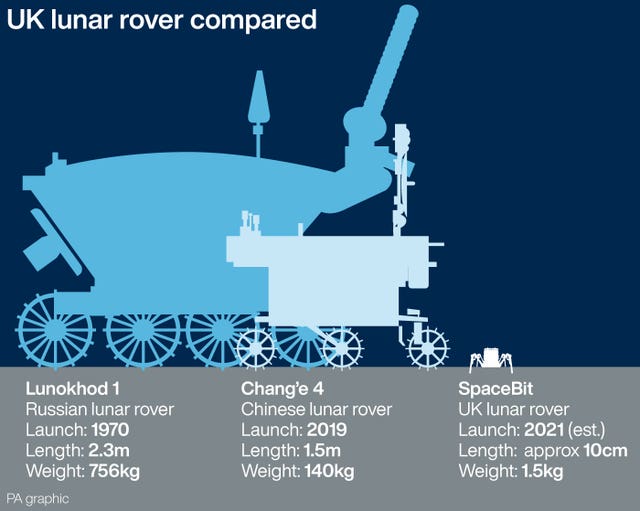
The UK’s first Moon rover will be sent into space in 2021.
The world’s smallest robotic Moon rover, with legs instead of wheels, will be part of the first set of payloads to be sent to the astronomical body.
Announced at the New Scientist Live event in London’s ExCeL, UK-grown start-up space company SpaceBit created and designed the robot.
SpaceBit founder Pavlo Tanasyuk said: “Our goal is to go there and see what is available there for all humanity to explore.”
He added that, unlike rovers with wheels or tracks, this robot with four legs would provide an opportunity for “something a little bit like a human” to explore the lunar surface.

Only three other countries have previously put a rover on the Moon – the US, Russia and China.
In May, Nasa announced that Astrobotic and two other companies had been awarded funding to build lunar landers.
Astrobotic was awarded millions of dollars to carry up to 14 Nasa instruments to the Moon as well as 14 payloads from other partners.
SpaceBit will be one of those partners, sending the rover to the surface inside Astrobotic’s Peregrine lander.
It is expected to land near the region of Mare Serenitatis – the Sea of Serenity – in June or July 2021.
Once the lander reaches the Moon, the 3lb 5oz (1.5kg) rover will drop from beneath it to the surface along with other payloads.
It will scuttle across the surface taking measurements and collecting exploration data that can be analysed for scientific and exploration purposes.
The rover is battery-powered, but a small solar panel will also harness energy from the Sun.
It also has two cameras that will enable it to take “robot selfies”, SpaceBit said.
The reason for the legs is that, in future lunar missions, the rover will go into lava tubes, which has not been possible before.
Ukrainian-born Mr Tanasyuk said: “After we land, we will be exploring the Moon surface, as well as, hopefully, we will be able to the get into the lava tubes and explore the environment there.
“So we hope to find a stable temperature which will be suited for future human missions to the Moon.
“It is a rugged environment in the lava tubes so you can’t really use wheels there – that was why we had to design these legs instead of wheels.”
The SpaceBit rover can withstand temperatures from up to 130C (266F) to minus 130C (minus 202F) at night, and will explore for the duration of a lunar day.
Mr Tanasyuk added: “It will spend up to 10 days on the Moon before going into the night and basically freezing forever.”
While the robot has an in-house name, this has not been made public as SpaceBit hopes to launch a competition in the UK, asking children to name it.